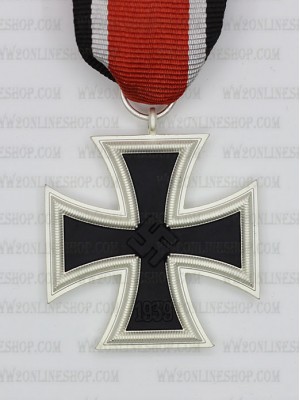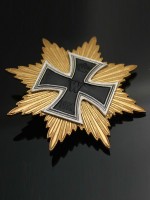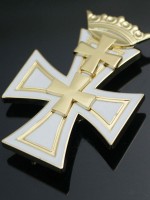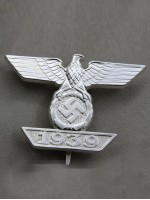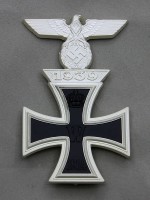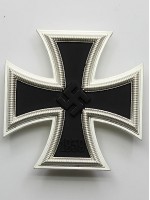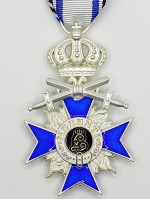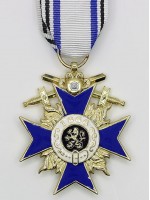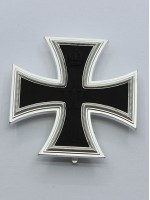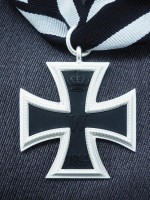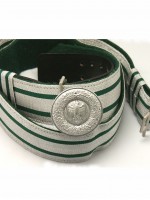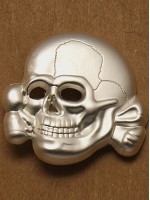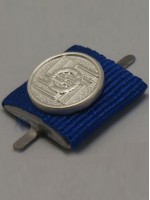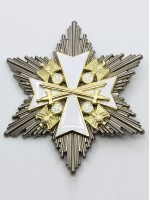Your shopping cart is empty!
Welcome visitor you can login or create an account.
Categories
Bestsellers
German WWII Iron Cross (Eisernes Kreuz) 2nd Class
Product Code: MD065
Availability: In Stock
Availability: In Stock
Price: USD$35 USD$25
Ex Tax: USD$25
Qty:
German WWII Iron Cross (Eisernes Kreuz) 2nd Class
Box/Case is not included. The Iron Cross (German:Eisernes Kreuz) is a cross symbol typically in black with a white or silver outline that originated after 1219 when the Kingdom of Jerusalem granted the Teutonic Order the right to combine the Teutonic Black Cross placed above a silver Cross of Jerusalem.The military decoration called the Iron Cross which existed in the Kingdom of Prussia, and later in the German Empire and Third Reich, was established by King Friedrich Wilhelm III of Prussia and first awarded on the 10th of March in 1813 during the Napoleonic Wars. The recommissioned Iron Cross was also awarded during the Franco-Prussian War, World War I, and World War II. The Iron Cross was normally a military decoration only, though there were instances of it being awarded to civilians for performing military functions. Two examples of this were civilian test pilots Hanna Reitsch who was awarded the Iron Cross 2nd Class and 1st Class and Melitta Schenk Gräfin von Stauffenberg, who was awarded the Iron Cross 2nd Class, for their actions as pilots during World War II.
The Iron Cross was used as the symbol of the German Army from 1871 to March/April 1918, when it was replaced by the bar cross. The Iron Cross was reintroduced as an award in the Wehrmacht in 1939 with a Swastika added in the center during the Third Reich in World War II. In 1956, the Iron Cross resumed its German military usage, as it became the symbol of the Bundeswehr, the modern German armed forces. The traditional design is black and this design is used on armored vehicles and aircraft. A newer design in blue and silver is used as the emblem in other contexts.
On 17 March 1813, Frederick William III – who had fled to the non-occupied Breslau – established the military decoration of the Iron Cross, backdated to 10 March, late Queen Louise's birthday.[4] The Iron Cross was awarded to soldiers during the Wars of Liberation against Napoleon. It was first awarded to Karl August Ferdinand von Borcke on 21 April 1813.[5] King Wilhelm I of Prussia authorized further awards on 19 July 1870, during the Franco-Prussian War. Recipients of the 1870 Iron Cross who were still in service in 1895 were authorized to purchase and wear above the cross a Jubiläumsspange ("Jubilee clip"), a 25-year clasp consisting of the numerals "25" on three oak leaves.[3]
The Iron Cross was reauthorized by Emperor Wilhelm II on 5 August 1914, at the start of World War I. During these three periods, the Iron Cross was an award of the Kingdom of Prussia, although given Prussia's pre-eminent place in the German Empire formed in 1871, it tended to be treated as a generic German decoration. The 1813, 1870, and 1914 Iron Crosses had three grades:
Iron Cross 2nd Class (German: Eisernes Kreuz 2. Klasse, or EKII)
Iron Cross 1st Class (German: Eisernes Kreuz 1. Klasse, or EKI)
Grand Cross of the Iron Cross (German: Großkreuz des Eisernen Kreuzes, often simply Großkreuz)
Although the medals of each class were identical, the manner in which each was worn differed. Employing a pin or screw posts on the back of the medal, the Iron Cross 1st Class was worn on the left side of the recipient's uniform. The Grand Cross and the Iron Cross 2nd Class were suspended from different ribbons.
The Grand Cross was intended for senior generals of the Prussian or later German Army. An even higher decoration, the Star of the Grand Cross of the Iron Cross (also called the Blücher Star), was awarded only twice, to Generalfeldmarschall Gebhard Leberecht von Blücher in 1813 and to Generalfeldmarschall Paul von Hindenburg in 1918. A third award was planned for the most successful German general during World War II, but was not made after the defeat of Germany in 1945.
The Iron Cross 1st Class and the Iron Cross 2nd Class were awarded without regard to rank. One had to possess the 2nd Class already in order to receive the 1st Class (though in some cases both could be awarded simultaneously). The egalitarian nature of this award contrasted with those of most other German states (and indeed many other European monarchies), where military decorations were awarded based on the rank of the recipient. For example, Bavarian officers received various grades of that Kingdom's Military Merit Order (Militär-Verdienstorden), while enlisted men received various grades of the Military Merit Cross (Militär-Verdienstkreuz). Prussia did have other orders and medals which were awarded on the basis of rank, and even though the Iron Cross was intended to be awarded without regard to rank, officers and NCOs were more likely to receive it than junior enlisted soldiers.
During World War I, approximately 218,000 EKIs, 5,196,000 EKIIs and 13,000 non-combatant EKIIs were awarded. Exact numbers of awards are not known, since the Prussian military archives were destroyed during World War II. The multitude of awards reduced the status and reputation of the decoration. Among the holders of the 1914 Iron Cross 2nd Class and 1st Class was Adolf Hitler, who held the rank of Gefreiter. Hitler can be seen wearing his EKI on his left breast, as was standard, in most photographs.
Write a review
Your Name:Your Review: Note: HTML is not translated!
Rating: Bad Good
Enter the code in the box below:
Related Products (10)
Random Products







